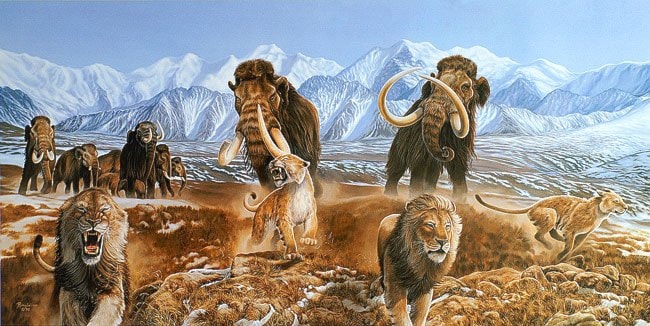The icon of the mammoth steppe, Mammuthus primigenius, is well represented in the Yukon’s fossil record. Thanks to remains preserved in permafrost from the Klondike gold fields and Old Crow, we’re wealthy when it comes to mammoth teeth, bones and tusks.
“The woolly mammoth is an incredibly important animal for understanding ice-age habitat,” says Rachel Schwartz-Narbonne, a PhD student at the University of Western Ontario and lead author of a paleontological study published in Nature Scientific Reports last month: “Solving the woolly mammoth conundrum: amino acid 15N-enrichment suggests a distinct forage or habitat.”
“It’s fascinating to think, ‘How on Earth did this species manage to survive in something we would consider a hostile environment?’” she says. We have Yukon specimens of mammoth from 140,000 to 18,000 years ago, a period of time of drastic climate changes. (The Pleistocene epoch lasted from 2.6 million years ago to 11,700 years ago).
And the mammoth steppe, a dry, cold and wind-swept land of tough grasses, was also home to horses, short-faced bears, steppe bison and other mega-critters that once thrived along a huge swath of habitat between
Spain and Yukon and then disappeared in a late-Pleistocene extinction. Schwartz-Narbonne likens the highly populated long-ago steppe to today’s African savannah.
“You are going to have to understand how they lived if you are going to understand what factors were involved in their extinction,” she says. “Trying to liken the African savannah to ice-age Yukon, you get an incredible mental image.”
It’s also a disturbing image, given rapid changes to today’s climate and ecosystems.
“(Mammoths) were a keystone herbivore, which means they created the habitat they lived in,” she says. During their travels, they transported shoots and seeds. They stirred and aerated soils. By defecating they nourished plants. By grazing and browsing they determined the foods available for other herbivores.
But those same busy mammoths have been creating confusion back at the laboratory. That confusion, or amazement, came to be called “the woolly mammoth conundrum.”
“Mammoths were herbivores, right?” says Schwartz-Narbonne. They mainly ate grasses. The gut contents, handily preserved in Yukon permafrost, told scientists so. Fragments of meals trapped in mammoth teeth told scientists so.
Nitrogen begged to differ.
“When we looked further, we found this really high value for nitrogen isotopes, which suggested this was a carnivore, but we knew it wasn’t a carnivore – that meant something really weird was going on with the woolly mammoth,” she says.
The image of a woolly mammoth tearing at animal flesh was hard for paleontologists and other scientists to digest. And that was one of the reasons Schwartz-Narbonne’s co-author and supervisor Fred J. Longstaffe, her then graduate student colleague and peer, mentor Jessica Z. Metcalfe and colleague Yukon paleontologist Grant Zazula wanted someone with a strong chemistry background, like Schwartz-Narbonne, also working on this project.
“(The mammoth) was either eating something very different – still grasses, but distinct grasses,” she says. “Or it was living in a very distinct habitat from other herbivores with lower nitrogen values, or it had some kind of weird physiological mechanism, which made it look like a carnivore in its isotopes even though in every other way it was clearly a herbivore.”
She and her colleagues started looking into bulk protein preserved in mammoth bones and teeth. “We broke down the bulk protein into individual amino acids, which are the building blocks.” These confirmed that mammoths shared basically the same dietary physiology as other herbivores. The evidence, however, also suggested a distinct diet or a distinct habitat.
One of the suggestions made was that woolly mammoth were living apart – in an area that was especially dry. Another possibility was that mammoth were eating some kind of food other herbivores didn’t want or couldn’t get at. With their long tusks and big feet mammoths would have been able to brush snow aside to get at decayed plants below – plants with time-altered nitrogen isotopes.
Mammoths might have used the same migration routes repeatedly, depositing dung to and fro. They would then have been eating grass repeatedly fertilized with their own feces and whatever nutrients that contained.
“Woolly mammoths were very influenced by the climate they lived in,” says Schwartz-Narbonne. If they required distinct habitat and food any change to climate or vegetation could have had devastating effects.
Climate change is forcing today’s scientists to master a variety of disciplines and employ ever-evolving research tools and techniques, she says. “The most exciting work that needs to be done is at the edge of fields,” she adds. The boundaries of disciplines are being challenged, as is the case with anthropology.
While organisms of all sizes were facing drastic changes in late-Pleistocene habitat, human hunters showed up.
It is too soon, however, to pronounce definite conclusions about the cause or causes for extinctions. “It is important to keep an open mind,” says the scientist.
Schwartz-Narbonne says she never intended to become a paleontologist. There was already one in the family, her father, who specializes in the very first animals. After late-night debates with herself over university catalogues and course schedules, she came to a place where many disciplines meet, including traditional morphology (the study of organism structures and their functions), physics, geology, chemistry, mathematics, archeology, and who knows what else?
That’s the wonderful thing about this interdisciplinary work – there are still questions that can be thought through by people with very different backgrounds, says Schwartz-Narbonne.
All thinking together they may soon be able to tell us where the Yukon’s woolly mammoths went ... and why.
This column is co-ordinated by the Yukon Research Centre at Yukon College with major financial support from Environment Yukon and Yukon College. The articles are archived at http://www.yukoncollege.yk.ca/research/publications/your_yukon
